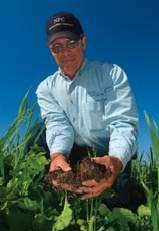Dan Forgey has always had an abiding respect for the land that he’s farmed for more than 40 years, which is why, as manager of the 8,500-acre Cronin Farms in Gettysburg, South Dakota, he strives to build soil health—and yields—sustainably. First, he shifted the farm to 100 percent no-till in 1993. Then in 2006, after spending years developing diverse crop rotations, he received a grant from Sustainable Agriculture Research and Education, a USDA-funded grants and outreach program, to test the introduction of cover crops into his system. This move has given him higher yields with fewer inputs, and therefore better profits.

“This is what the country needs. Between cover crops and no-till we are doing things to better the soil nature’s way,” Forgey says.
Over the years, Forgey has diversified the farm to include 12 crops—including grains, oilseed crops and forages for his 750-head cow-calf operation. He plants them in long rotations in order to combat weeds, which present a major challenge in no-till systems.
His SARE-funded cover crop research showed that a mix of turnips, cowpeas and lentils increased corn yields by 18-20 bushels per acre compared to control plots. Now, Forgey is helping other growers adopt the soil-building strategies. Potter County, where he lives, and nearby Sully County have become a hotbed of no-till in the last 20 years, where an estimated 80-90 percent of growers now use the practice. But cover crops have been slower to catch on, partly because not enough growers have demonstrated which covers work well in local growing conditions.
Forgey has worked hard to share his success with cover crops with neighbors. He has conducted on-farm tours, held field days, spoken at regional conferences and recently been profiled in the national agricultural media. Many of his neighbors have taken notice. Seven producers—their operations ranging in size from 3,500 to 18,000 acres—planted cover crops for the first time in 2008 after seeing Forgey’s plots.
To hear Forgey’s story in his own words, check out the recently-published video series about Cronin Farms, produced by SARE and Cooking Up a Story.
